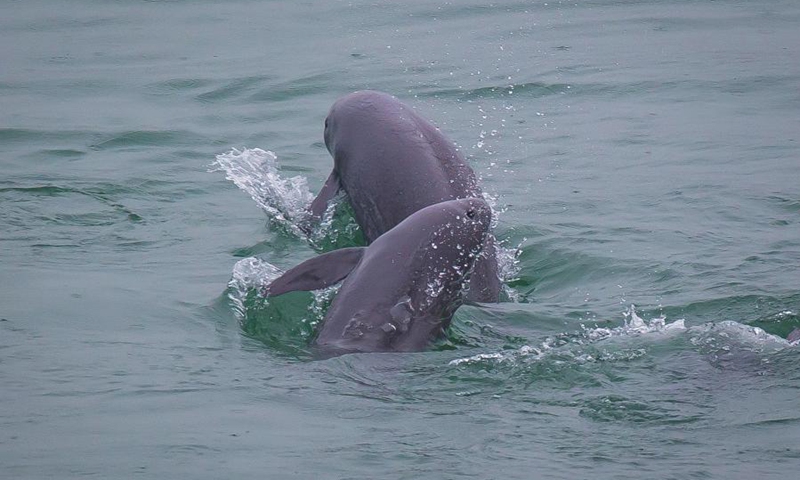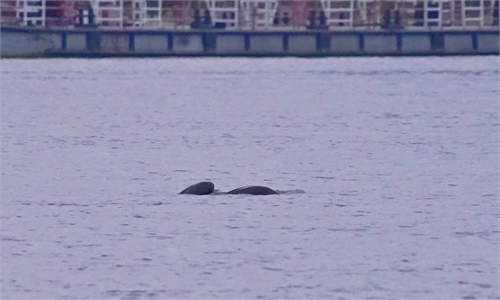More 'smiling angel' dolphins observed in Yangtze, heading toward effective recovery

Two Yangtze finless porpoises are seen at the Yichang section of the Yangtze River, central China's Hubei Province, May 10, 2021.(Photo:Xinhua)
More Yangtze finless porpoises, the critically endangered freshwater dolphin species endemic to China's longest river Yangtze, were observed during the latest scientific survey. Their activity areas were also found to be larger, with many first seen in some river sections.
"Compared with the number observed in 2017, we saw more Yangtze finless porpoises in the Yangtze River in the 2022 survey, especially in terms of mother and baby dolphins, and this indicates that the natural population has partly recovered," Jiang Meng, secretary-general of the Nanjing Yangtze Finless Porpoise Conservation Association, who participated in the survey in Jiangsu, told the Global Times on Thursday.
Six scientific research teams were sent to Central China's Hubei, East China's Anhui and Jiangsu provinces, as well as the Dongting Lake in Hunan Province and Poyang Lake in Jiangxi Province, to study the population and natural habitat of Yangtze finless porpoises from September 19 to mid-October.
The water areas where Yangtze finless porpoises live and move are getting larger and becoming more connected, Jiang said.
According to Jiang, the porpoises used to live in the cities of Nanjing and Zhenjiang in Jiangsu, but this time they observed the dolphins in several other cities along the Yangtze River, including Yangzhou, Taizhou, Wuxi, Suzhou and Nantong.
According to Liu Xiaoqiang, a researcher from the Ministry of Agriculture and Rural Affairs, the survey also found groups of the porpoises for the first time in the city of Wuhan in Hubei and the Chongming district in Shanghai.
"A more continuous population distribution throughout the middle and lower reaches of the Yangtze River will facilitate the migration and exchange of different dolphin groups," Liu told China Central Television on Thursday.
Jiang said that they also excitedly witnessed interactions between mother and baby dolphins in Nanjing, Zhenjiang, Yangzhou and Jingjiang. "It means the dolphin's populations are reproducing normally and heading toward effective recovery."
Researchers said the ministry will soon reveal the specific number of porpoises observed during the survey, after collecting and analyzing the data.

A researcher uses a pair of binoculars to conduct monitoring work during a scientific expedition on Yangtze finless porpoises at the Shishou section of the Yangtze River, central China's Hubei Province, Sept. 23, 2022. Photo: Xinhua
The Yangtze finless porpoise is called the "smiling angel" in China for its mouth fixed in a permanent grin. After its better-known cousin, the baiji dolphin, was declared "functionally extinct" in the same waters in 2007, experts believe the finless porpoise is the Yangtze's last surviving mammal.
Researchers said that mass artificial breeding of Yangtze finless porpoises would be challenging, even though China saved giant pandas from extinction through artificial reproduction.
Yangtze finless porpoises are social animals living in the water, and they have very strict requirements for breeding environments, the researchers said.
Following surveys in 2006, 2012 and 2017, which found the number of Yangtze finless porpoises in a continuous decline, the just-concluded survey was the first basin-based systematic survey of Yangtze finless porpoises after the implementation of the fishing ban in the Yangtze River basin in January 2020, which aimed at protecting and restoring the ecology.
"We didn't see any fishing boats or nets during the survey this time, and there were very few people fishing by the river," said Jiang. "We have indeed seen clear water, which means a better and better environment for the Yangtze finless porpoise."
With increasing attention of the Chinese public to the protection of these "smiling angels", China is ramping up efforts on legislation and public education.
The cities of Nanjing and Zhenjiang in Jiangsu and Ma'anshan in Anhui on Monday jointly implemented a decision to strengthen the protection of the species, which experts described as a ground-breaking move that will provide a wider range of protection.
Conservation centers are also under construction or being planned in some cities in Jiangxi and Jiangsu, according to researchers.



